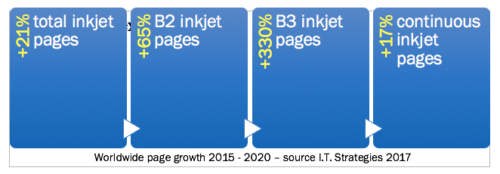Inkjet printing is undeniably the top growth segment within the document printing industry – possibly the overall printing industry. According to research by I.T. strategies, total inkjet pages are expected to grow (CAGR) by over 21% between 2015 and 2020 with some remarkable variations by format:
- B2 to sheet fed inkjet page growth of over 65%*
- B3 sheet fed inkjet page growth of over 330%*
- Comparatively modest, but still robust, continuous inkjet page growth of over 17%
* Sheet fed devices are relatively new to the market resulting in much higher percentage page growth. When you start at zero you get big percentages.

Despite what can be seen as very healthy growth rates, I would argue that the production inkjet market could be growing faster.
Barriers to Inkjet Growth
There are barriers to inkjet adoption from the perspective of device placements that we try to address here on Inkjet Insight. Barriers such as long evaluation timelines, development of the buyer’s business cases, substrate evaluation and linearization and raising awareness of the potential for inkjet print quality to meet or rival offset are often the topics of posts here on the Knowledgebase. But, there are barriers to the growth of inkjet that aren’t related to the placement of new devices, but rather to growth in inkjet pages. Growth in inkjet pages is the tide that lifts all boats.
Breaking Down Barriers to Inkjet Growth
Breaking down the barriers to the growth of inkjet pages falls squarely in the realm of customer education. We as an industry need to get print buyers and designers excited about the opportunities that inkjet can open up for them. We need to celebrate great design and encourage creatives to push inkjet and finishing technologies to do things perhaps we haven’t even thought about yet. It’s interesting to note that a substantial portion of production inkjet volumes are net-new pages that are not cannibalizing other aspects of print.
I recently had the opportunity to serve on the panel of judges for the 2018 HP Inkspiration Awards celebrating excellence in digital printing (and I’m looking forward to Dscoop where the winners will be announced). There were some truly inspiring entries across a range of application types – but less than 2% of the entries were produced on inkjet. We need your help to raise awareness of what is possible, so if you have clients that have designed amazing work that is produced on an inkjet device – let’s talk. I’d like to showcase their work.
At a more mundane and operational level, we also have to make it as easy as possible for creatives to understand and engage with the technology. Since these are highly visual folks, the best way to do that is to provide visuals for them to interact with. They primarily want to know what to expect in terms of color reproduction, image quality and text legibility on papers with the weights and finishes they require. This means that every print provider should be ready to provide:
- Fingerprint Images: A set of standard images intended to demonstrate minimum text and line sizes, solids, gradations and color fidelity for a particular paper (in combination with the inkjet printer). This is a tool to help customers select paper and also to design effectively for the paper selected.
- Tint/Swatch books provide customers with a template for requesting print swatches for various tints on their selected paper to help them find the closest matches to out-of-gamut colors.
- Sample Media Guide: paper samples for the standard papers you support. These paper samples should be available with examples of the types of projects for which each paper is recommended, as well as showing the standard fingerprint.
These tools are great for the sales team as well. Having these inkjet samples in their sales kit helps open the door with print buyers and designers alike.
We want to help the industry drive more pages to inkjet. Help us to help you. Take advantage of the many tools that we have provided on the site and share your success stories with us. Let’s work together to grow those inkjet pages faster than ever.
Elizabeth
